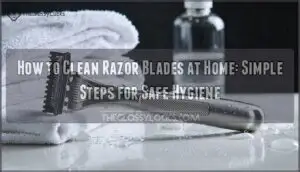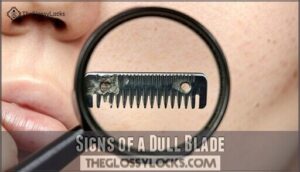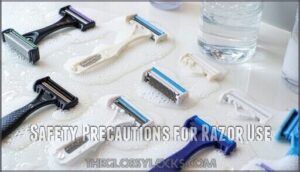This site is supported by our readers. We may earn a commission, at no cost to you, if you purchase through links.

For stubborn buildup, use a soft toothbrush to gently scrub between the blades.
Dry the razor by shaking off excess water and patting it with a towel—don’t rub, or you might dull the edge.
For extra hygiene, dip the blades in isopropyl alcohol to kill bacteria and speed up drying.
Store your razor in a dry place to prevent rust.
Curious about tackling mold or prolonging blade life? There’s more to this story.
Table Of Contents
- Key Takeaways
- Cleaning Razor Blades 101
- Removing Bacteria and Mold
- Maintaining Razor Blade Hygiene
- Signs of a Dull Blade
- Prolonging Blade Life
- Safety Precautions for Razor Use
- Replacing Razor Blades
- Razor Blade Care for Sensitive Skin
- Common Razor Blade Care Mistakes
- Advanced Razor Blade Care Techniques
- Frequently Asked Questions (FAQs)
- What is the best way to clean a razor blade?
- How do I disinfect my shaving razor?
- How to deep clean a shaving razor?
- Does vinegar clean razor blades?
- How do I keep my razor blades sharp and clean?
- How do you get rid of bacteria in a razor?
- How do you get black mold off a razor?
- How often should I disinfect my razor blades at home?
- Can I use a regular toothbrush to clean my razor?
- What is the best way to dry my razor blades?
- Conclusion
Key Takeaways
- Rinse your razor with hot water before and after each shave to remove hair, debris, and shaving cream buildup that can dull blades and harbor bacteria.
- Disinfect weekly by soaking the razor head in 70% isopropyl alcohol for 5-10 minutes to eliminate 99.9% of bacteria without needing to rinse afterward, ensuring optimal performance.
- Always air-dry your razor completely in an upright position after cleaning to prevent rust formation and bacterial growth in moist environments.
- Replace blades every 5-10 shaves when you notice pulling, increased irritation, or visible rust spots to maintain skin safety.
Cleaning Razor Blades 101
Proper razor blade cleaning starts with a thorough rinse under hot water to remove hair and shaving cream buildup.
You’ll need to disinfect regularly and dry completely to prevent bacteria growth and extend blade life.
Rinsing and Drying Techniques
Mastering proper razor cleaning techniques keeps your blades sharp and your skin healthy.
Hot water temperature above 40°C removes 96% of debris effectively.
Follow these essential steps:
- Hold razor under powerful hot water stream, rotating for complete coverage
- Tap gently to dislodge stubborn particles without damaging the blade
Use drying stands or upright storage for ideal air ventilation
and apply microfiber cloths carefully or air-dry completely before storing
Using a Razor Brush for Deep Cleaning
When regular rinsing isn’t enough, you’ll need a razor brush for deeper cleaning.
Select stiff-bristled brush types designed for razor blade cleaning. Use vertical cleaning strokes along the blade edges to dislodge compacted debris removal.
Alternative brushes like clean toothbrushes work effectively. A dedicated brush can help with effective razor maintenance.
Store your razor brush in dry areas for longevity. This deep clean method reaches spaces water can’t access.
Disinfecting With Isopropyl Alcohol
After thorough brushing, you’ll want to disinfect your razor blade with isopropyl alcohol for complete sterilization.
This step eliminates harmful bacteria that regular rinsing can’t remove.
- Alcohol Concentration: Use 70% isopropyl alcohol for maximum disinfection power
- Immersion Time: Submerge razor head for 5-10 minutes, swishing vigorously
- Rust Prevention: No rinsing needed—shake off excess and air-dry completely
This razor sterilization method prevents infections while extending blade life through proper drying methods.
Removing Bacteria and Mold
Bacteria and mold can quickly turn your razor from a grooming tool into a health hazard.
Here’s how to eliminate these microscopic threats and keep your razor clean and safe for daily use.
Soaking in Vinegar for Sanitization
Vinegar offers an effective, chemical-free approach to disinfect razor blade components. White vinegar’s 5% acetic acid content breaks down mineral deposits while providing mild antibacterial properties.
Mix one part vinegar with four parts water for regular maintenance, or use a 1:1 ratio for stubborn buildup. Electric razors, however, require different care, so check razor specifications before cleaning.
| Vinegar Types | Solution Strength | Soak Duration |
|---|---|---|
| White vinegar | 1:4 (vinegar:water) | 10-30 minutes |
| White vinegar | 1:1 (vinegar:water) | 15-30 minutes |
| Apple cider vinegar | 1:2 (vinegar:water) | 20-30 minutes |
| Distilled white | Pure vinegar | 5-10 minutes |
| Cleaning vinegar | 1:3 (vinegar:water) | 15-25 minutes |
Always rinse thoroughly after soaking to prevent corrosion on blade material surfaces.
Using Hydrogen Peroxide for Disinfection
Hydrogen peroxide transforms razor blade hygiene through powerful disinfection. This affordable antiseptic eliminates bacteria and viral contamination when properly applied.
Hydrogen peroxide is a game-changer—wiping out germs and keeping your razor fresh with minimal effort.
Regular cleaning helps prevent bacterial and fungal growth.
Follow these steps for effective razor disinfection:
- Mix Solution – Combine equal parts hydrogen peroxide and water to achieve safe H2O2 concentration
- Submerge Components – Fully immerse disassembled razor parts in the solution
- Control Soak Duration – Allow 10-15 minutes for complete bacterial elimination
- Dry Thoroughly – Pat components completely dry to prevent residue concerns and bacterial regrowth
Preventing Black Mold Growth
After disinfecting with hydrogen peroxide, you’ll want to stop razor mold before it starts.
Black mold thrives in damp conditions, so proper drying becomes your best defense.
Regular razor disinfection is also essential for preventing bacterial growth.
Mold Prevention Tips Humidity Control Methods Cleaning Solution Options
Ventilation importance can’t be overstated—air circulation prevents moisture buildup that feeds mold growth.
Regular inspection helps catch problems early, while storage solutions like protective cases maintain razor blade hygiene between uses.
Maintaining Razor Blade Hygiene
Proper razor hygiene prevents bacterial growth and extends blade life substantially.
You’ll need to store your razor correctly, avoid sharing it with others, and replace blades on a regular schedule to maintain ideal performance and safety.
Storing Razors in Dry Places
Moisture is the enemy of razor maintenance. For the best razor storage, focus on humidity control and proper drying methods.
A dry razor is a happy razor—moisture kills blades faster than dull edges.
Upright storage and good ventilation importance can’t be overstated for rust prevention and blade longevity. Avoid leaving your razor in damp spots.
- Use a breathable razor case
- Store upright in a dry, well-ventilated spot
- Avoid the shower area
- Keep away from direct sunlight to ensure proper drying methods are effective.
Avoiding Sharing Razors
Razor blade sharing creates serious health risks through cross-contamination and infection transmission.
Keep guest razors available for visitors and label your personal razor for Family Awareness.
This simple step in Hygiene Practices prevents accidental sharing while maintaining Personal Identification of your equipment.
Razor Sharing Risks Infection Prevention Tips Safe Shaving Practices
Replacing Blades Regularly
Beyond avoiding shared razors, blade replacement timing directly impacts your safety and comfort.
Replace blades every 5-10 shaves when blade sharpness declines. Signs include shaving discomfort, pulling, or irritation.
Regular razor replacement prevents cuts and maintains maximum blade lifespan. Though cost analysis shows frequent changes increase expenses, the environmental impact and health benefits justify consistent razor blade replacement schedules.
Signs of a Dull Blade
You’ll know it’s time to replace your blade when shaving becomes uncomfortable and less effective.
A dull razor creates noticeable pulling, increased irritation, and visible signs of wear that compromise your shaving experience, making the shaving process less enjoyable.
Recognizing Pulling and Roughness
A few key signs reveal when dull blades are compromising your shave.
If you notice blade drag or shaving discomfort where the razor seems to pull at your hair instead of cutting cleanly, it’s time for blade replacement.
Hair trapping between dulled edges creates uneven shave results and increases skin sensitivity.
Sharp razor blade edges glide smoothly, while razor dullness forces you to apply extra pressure, creating that telltale tugging sensation.
Identifying Increased Irritation
When your skin turns into a battlefield after shaving, it’s sending clear signals about razor blade sharpness.
Post-shave irritation, razor burn signs, and redness and bumps indicate your blade needs replacement for proper razor hygiene.
- Razor burn – Red, burning sensation immediately after shaving
- Ingrown hairs – Bumps forming when hair curls back into skin
- Increased redness – Skin appears more inflamed than usual
- Persistent bumps – Raised areas that don’t subside quickly
- Stinging sensation – Sharp pain during or after razor cleaning routine
Checking for Rust and Corrosion
The telltale signs of rust and corrosion appear as orange or reddish-brown spots along blade edges.
Early detection through regular inspection prevents deeper damage and maintains blade integrity. Check for pitting or flaking metal, which compromises sharpness.
Storage impact accelerates corrosion prevention needs—humid environments worsen razor rust.
Address rusty razor blades immediately with gentle rust removal techniques to restore performance.
Prolonging Blade Life
You can substantially extend your razor blades’ lifespan with proper maintenance techniques that prevent premature dulling and corrosion.
Regular care routines keep blades sharp longer, saving you money and ensuring consistently smooth shaves.
Rinsing Thoroughly After Each Use
Proper rinsing keeps your razor performing like new.
Follow these essential cleaning razor blades steps:
- Water Temperature: Use hot water (above 40°C) to dissolve 96% of shaving cream and hair debris
- Rinsing Frequency: Rinse before and after each shave for ideal blade lubrication and residue removal
- Pressure Matters: Direct a strong stream from multiple angles to dislodge compacted particles
- Pre-Shave Rinse: Always rinse blade beforehand to activate lubrication and prevent razor debris buildup.
Consider weekly alcohol disinfection for optimal hygiene.
Using a Plastic Guard for Protection
During travel or storage, plastic guards offer essential travel protection for your razor blades.
These simple covers prevent accidental contact that causes dulling, extending blade longevity substantially.
Guard benefits include preventing damage from drops and contact with other items.
Safe handling becomes effortless when guards shield sharp edges, making razor blade care and razor blade maintenance worry-free.
Replacing Blades After 5-10 Shaves
Beyond protective guards, tracking your razor blade replacement frequency becomes your next line of defense.
Smart shave count tracking reveals when blades lose their edge, typically after 5-10 uses depending on hair thickness and shaving habits.
Here are four performance decline signs that signal replacement time:
- Pulling sensation – Your razor drags instead of gliding smoothly across skin
- Increased irritation – More razor burn, bumps, or ingrown hairs appear post-shave
- Visible rust spots – Orange or dark patches indicate blade sharpness retention has failed
- Tugging hair – Blades cut poorly, requiring multiple passes over the same area
Regular blade sharpness monitoring through cost-benefit analysis shows that extending razor life beyond 10 shaves often costs more in skin damage than replacement expenses.
Safety Precautions for Razor Use
You’ll want to take extra care when handling razor blades to avoid cuts and accidents during cleaning.
Keep disposable razors available for guests and label your personal razors to prevent mix-ups that could spread bacteria or infections.
Preventing Accidents and Injuries
Safe razor handling starts with proper storage—keep razors in a sharps container or secure case away from children and pets.
When disposing of dull blades, use designated disposal methods to prevent accidental cuts.
Always have first aid supplies nearby for minor nicks.
Practice careful blade handling by never touching the cutting edge directly, and maintain child safety by storing razors in locked cabinets or high shelves where curious hands can’t reach them.
Keeping Disposable Razors on Hand
Having disposable razors on hand prevents sharing your personal razor and maintains proper razor cleaning methods.
Stock these travel razor options for guests and emergencies to guarantee everyone has access to clean, hygienic shaving tools.
- Bulk Razor Buying – Purchase multipacks for cost-effective disposable razor storage
- Guest Razor Etiquette – Offer fresh razors to visitors instead of sharing yours
- Travel Razor Options – Keep backup razors for unexpected trips or delays
- Razor Brand Variety – Stock different types to accommodate various preferences
Labeling Razors for Easy Identification
Each family member deserves their own razor to prevent razor sharing risks and maintain personal hygiene.
Smart razor labeling eliminates confusion and protects everyone’s safety. Color coding systems work perfectly for preventing mix-ups among family members.
| Labeling Method | Best For | Safety Benefit |
|---|---|---|
| Color coding bands | Family members | Instant identification |
| Initial stickers | Personal use | Clear ownership |
| Bright tape | Guest razors | Prevents accidental sharing |
| Numbered labels | Multiple bathrooms | Easy tracking system |
Keep guest razors clearly marked and separate from personal razors for maximum razor blade labeling effectiveness.
Replacing Razor Blades
Even the sharpest blade eventually loses its edge, and knowing when to replace yours keeps your shave smooth and irritation-free.
You’ll find several options for replacement blades, from convenient refill cartridges to switching to electric razors for easier maintenance.
Choosing The Right Replacement Blades
When replacing razor blades, matching your selection to your specific needs guarantees peak performance.
Blade Material affects durability and sharpness retention.
Consider Blade Count based on your skin sensitivity and hair thickness.
Verify Razor Compatibility with your handle model.
Factor in your Skin Type when choosing coating options.
Conduct a Cost Analysis comparing refill prices versus blade quality and razor blade lifespan.
Many users prefer blades based on their specific material properties.
- Platinum-coated blades gliding smoothly across sensitive skin without irritation
- Five-blade cartridges effortlessly cutting through thick, coarse facial hair
- Safety razor blades fitting perfectly into vintage handles from decades past
- Ceramic-coated edges maintaining their sharpness through multiple weekly shaves
- Budget-friendly steel blades delivering reliable performance at half the cost
Using Razor Blade Refills for Convenience
Razor blade refills offer smart cost savings compared to buying new handles repeatedly.
Most brands provide cartridge variety with different blade counts and features.
Subscription services deliver refills automatically, ensuring you never run out.
Easy swapping takes seconds—just click the old cartridge off and snap the new one on.
For travel convenience, pack lightweight refills instead of bulky disposable razors, keeping your razor maintenance tips simple while helping extend razor life through proper razor cleaning.
Considering Electric Razors for Ease
Switching to electric razors eliminates traditional razor cleaning challenges while offering consistent performance.
Consider these electric advantages:
- Foil vs Rotary: Foil razors suit sensitive skin, while rotary models handle thick hair better
- Corded vs Cordless: Cordless options provide travel convenience and bathroom flexibility
- Cleaning Electrics: Most feature self-cleaning stations that automatically sanitize cutting heads
- Replacement Heads: Change every 12-18 months for ideal razor maintenance tips and performance
Razor Blade Care for Sensitive Skin
If you have sensitive skin, you’ll need to handle razor blade cleaning with extra care to avoid irritation.
Choose mild cleaning products and gentle techniques that won’t leave harsh residues on your blades, using methods that preserve the blades.
Using Gentle Cleaning Products
For sensitive skin, choose mild soap or chemical-free cleaners to clean razor blades safely.
Apply these safe ingredients using gentle brush application with product dilution when needed. This approach minimizes skin sensitivity while ensuring thorough residue removal.
Homemade razor cleaning solutions work well—just avoid harsh chemicals that irritate delicate skin during your cleaning routine. This ensures that you can maintain your razor blades without causing skin sensitivity.
Avoiding Harsh Disinfectants
When sanitizing your razor, avoid harsh chemicals that can trigger skin irritation and blade damage.
Product ingredients like bleach or ammonia create more problems than they solve.
Instead, choose gentle alternatives for safe disinfecting – vinegar and hydrogen peroxide work as effective natural razor cleaners.
Some individuals may benefit from using hypoallergenic razor blades to further minimize irritation.
These homemade razor cleaner options deliver thorough sanitization without compromising your skin’s health or your razor’s integrity.
Storing Razors in Cool, Dry Places
Proper storage location can make or break your razor blade storage routine. Cool dry storage prevents mold prevention and extends blade longevity substantially.
Your bathroom’s humidity creates the perfect breeding ground for bacteria and rust.
Here’s your storage game plan:
- Humidity Control: Keep razors away from steamy showers and use silica gel packets in storage containers
- Upright Storage: Stand razors vertically on counters or in dedicated holders for ideal razor drying
- Protective Cases: Invest in breathable cases that shield blades while allowing airflow circulation
- Material Matters: Choose plastic or metal storage over fabric pouches that trap moisture
Common Razor Blade Care Mistakes
Even experienced shavers make simple errors that can damage their razors and irritate their skin.
These common mistakes include skipping proper rinsing, sharing blades with others, and failing to dry razors completely after use.
Not Rinsing Thoroughly
Skipping your rinse routine sets you up for disaster.
Shaving cream residue and hair clogs create the perfect storm for debris buildup and bacterial growth.
Warm water removes 96% of contaminants, preventing corrosion risk and blade dullness.
Thorough rinsing keeps blades sharp and reduces skin irritation during your next shave.
Sharing Razors With Others
Sharing razors spreads infection risks and skin conditions between users. Razor blade sharing risks include transmitting bacteria, viruses, and fungi through microscopic cuts. Crosscontamination occurs when blood or skin cells transfer between people, creating serious health hazards.
Keep guest razors available instead of allowing family sharing of personal blades. Proper hygiene practices require individual razor ownership to prevent razor blade infection transmission.
Sharing deterrence strategies include:
- Label your razor with colored tape or markers
- Store personal razors in separate bathroom areas
- Purchase disposable razors specifically for guests
- Educate family members about contamination dangers
Not Drying Razors Properly
Leaving your razor wet after shaving creates the perfect breeding ground for rust prevention nightmares and mold growth.
Water trapped between blades accelerates bacterial buildup, dramatically shortening blade lifespan.
Proper drying methods involve shaking off excess water, then air-drying upright in a ventilated area.
This simple step transforms razor blade care from frustrating to foolproof.
Advanced Razor Blade Care Techniques
You can use professional-grade tools to clean your razor blades beyond basic rinsing and alcohol soaks.
These advanced methods include ultrasonic cleaners that use sound waves to remove microscopic debris, UV sanitizers that kill bacteria without chemicals, and protective storage cases that maintain blade sharpness longer, utilizing advanced techniques for optimal results.
Using Ultrasonic Cleaners for Deep Cleaning
Ultrasonic cleaners use high-frequency sound waves to create microscopic bubbles that penetrate blade crevices, removing stubborn debris manual cleaning can’t reach.
These advanced cleaning techniques operate at 40-48kHz ultrasonic frequency with 2-5 minute cycle duration.
Simply submerge your razor in appropriate cleaning solutions, run the cycle, and enjoy thorough residue removal that extends device longevity while maintaining peak razor performance.
Sanitizing With UV Light
For razor blade disinfection, UV light sanitizers are remarkably effective—zapping up to 99.9% of germs in just a few minutes.
Always check bulb lifespan and follow the recommended exposure time for your sanitizer type.
To maximize UV effectiveness, pre-clean your razor, make certain all surfaces get direct light, and heed safety concerns—never expose skin or eyes to active UV, as this ensures the proper use of the sanitizer.
Storing Razors in Protective Cases
After UV sanitization, protect your razor blades with quality protective cases.
Choose hard plastic or leather case material for durability and blade protection. Travel cases prevent nicks while addressing hygiene concerns.
Proper razor storage tips include ventilated designs that maintain case longevity. Quality razor cases shield edges from damage, extending your razor care routine’s effectiveness substantially.
To prevent corrosion, consider storing in dry places.
Frequently Asked Questions (FAQs)
What is the best way to clean a razor blade?
Don’t let bacteria and buildup ruin your shave!
Rinse your blade thoroughly with hot water, then disinfect by soaking in 70% isopropyl alcohol for five minutes.
Before completing the process, air-drying completely is essential.
How do I disinfect my shaving razor?
Submerge your razor head in 70% isopropyl alcohol for 5-10 minutes to kill 9% of bacteria. No rinsing needed afterward—just shake off excess and air-dry completely.
How to deep clean a shaving razor?
Like a surgeon’s precision instrument, your razor needs thorough attention.
Mix equal parts Simple Green and water, then use a soft-bristled toothbrush to scrub between blades, removing stubborn buildup and bacteria completely.
This process ensures your razor is clean and free from harmful bacteria.
Does vinegar clean razor blades?
Yes, vinegar effectively cleans razor blades.
Mix one part vinegar with two parts water, then soak your blade for ten minutes.
This solution dissolves mineral deposits and sanitizes, restoring sharpness while removing buildup naturally.
How do I keep my razor blades sharp and clean?
Rinse your razor with hot water before and after shaving, then air-dry upright.
Disinfect weekly with rubbing alcohol, and store in a dry spot.
Replace blades at the first sign of dullness or rust for best results.
How do you get rid of bacteria in a razor?
Common bacteria thrive on razor blades, with studies showing 9% elimination through proper disinfection.
Soak your razor head in 70% isopropyl alcohol for 5-10 minutes after each use, then air-dry completely to prevent bacterial growth.
How do you get black mold off a razor?
Soak your razor in 70% isopropyl alcohol for 10 minutes to kill mold. Scrub gently with an old toothbrush, then rinse with hot water and air-dry completely.
How often should I disinfect my razor blades at home?
You should disinfect your razor blades weekly using 70% isopropyl alcohol. Soak the razor head for 5-10 minutes to eliminate 9% of bacteria and maintain proper hygiene between uses.
Can I use a regular toothbrush to clean my razor?
Like a dental hygienist using precision instruments, you’ll need the right tools for blade maintenance.
Yes, you can use a regular toothbrush to clean razor blades.
Choose an unused, soft-bristled toothbrush and glide it vertically over blades with smooth strokes to remove stubborn debris.
What is the best way to dry my razor blades?
Air-dry your razor upright in a well-ventilated area to prevent rust.
Avoid towels which can cause micro-nicks.
You can speed things up with a microfiber cloth or hair dryer on cool setting.
Conclusion
Like a well-maintained tool that serves you faithfully, learning how to clean razor blades at home guarantees peak performance and hygiene.
You’ve discovered that proper cleaning involves thorough rinsing, gentle brushing, and complete drying after each use.
Regular disinfection with isopropyl alcohol eliminates bacteria, while proper storage prevents rust and extends blade life.
Following these straightforward techniques keeps your razor sharp, safe, and ready for your next shave while protecting your skin from irritation and infection, ensuring complete hygiene.
- https://en.wikipedia.org/wiki/Isopropyl_alcohol
- https://cooljarz.com/collections/child-resistant-containers
- https://gausium.com/charging-docks/
- https://www.badgerandblade.com/forum/threads/how-do-i-sterilize-a-razor.241718/
- https://www.kentofinglewood.com/blogs/news/how-to-clean-maintain-your-double-edge-safety-razor
















